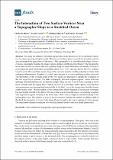Files in this item
The interaction of two surface vortices near a topographic slope in a stratified ocean
Item metadata
| dc.contributor.author | de Marez, Charly | |
| dc.contributor.author | Carton, Xavier | |
| dc.contributor.author | Morvan, Mathieu | |
| dc.contributor.author | Reinaud, Jean Noel | |
| dc.date.accessioned | 2017-10-31T16:30:30Z | |
| dc.date.available | 2017-10-31T16:30:30Z | |
| dc.date.issued | 2017-12 | |
| dc.identifier | 251387809 | |
| dc.identifier | 8c9a2b03-e199-4071-94dd-22f2652581d2 | |
| dc.identifier | 85063749863 | |
| dc.identifier | 000417975700009 | |
| dc.identifier.citation | de Marez , C , Carton , X , Morvan , M & Reinaud , J N 2017 , ' The interaction of two surface vortices near a topographic slope in a stratified ocean ' , Fluids , vol. 2 , no. 4 , 57 . https://doi.org/10.3390/fluids2040057 | en |
| dc.identifier.issn | 2311-5521 | |
| dc.identifier.other | ORCID: /0000-0001-5449-6628/work/38124095 | |
| dc.identifier.uri | https://hdl.handle.net/10023/11972 | |
| dc.description.abstract | We study the influence of bottom topography on the interaction of two identical vortices in a two-layer, quasi-geostrophic model. The two vortices have piecewise-uniform potential vorticity, and are lying in the upper layer of the model. The topography is a smooth bottom slope. For two cyclones, topography modifies the merger critical distance and the merger efficiency: the topographic wave and vortices can advect the two cyclones along the shelf when they are initially far from it, or towards the shelf when they are initially closer to it. They can also advect the two cyclones towards each other, and thus favour merger. The topographic wave and vortices exert a deformation on these cyclones, which filament. Regimes of partial vortex merger or of vortex splitting are then observed. The interaction of the vorticity poles in the two layers are analysed to explain the evolution of the two upper layer cyclones. For taller topography, two new regimes appear: vortex drift and splitting, and filamentation and asymmetric merger. They are due to the hetonic coupling of lower layer vorticity with the upper vortices, or to the strong shear that the former exert on the latter. The interaction of two anticyclones shows regimes of co-rotation or merger, but specifically, it leads to the drift of the two vortices away from the slope, via a hetonic coupling with opposite signed vorticity in the lower layer. This vorticity originates in the breaking of the topographic wave. The analysis of passive tracer evolution confirms the inshore or offshore drift of the fluid, the formation of tracer fronts along filaments and its mixing in regions of vortex merger. The trajectories of particles indicates how the fluid initially in the vortices is finally partitioned. | |
| dc.format.extent | 25 | |
| dc.format.extent | 20552078 | |
| dc.language.iso | eng | |
| dc.relation.ispartof | Fluids | en |
| dc.subject | Vortex interaction | en |
| dc.subject | Topography | en |
| dc.subject | Quasi-geostrophic model | en |
| dc.subject | QA Mathematics | en |
| dc.subject | QC Physics | en |
| dc.subject | T Technology | en |
| dc.subject | NDAS | en |
| dc.subject.lcc | QA | en |
| dc.subject.lcc | QC | en |
| dc.subject.lcc | T | en |
| dc.title | The interaction of two surface vortices near a topographic slope in a stratified ocean | en |
| dc.type | Journal article | en |
| dc.contributor.institution | University of St Andrews. Applied Mathematics | en |
| dc.contributor.institution | University of St Andrews. Scottish Oceans Institute | en |
| dc.identifier.doi | 10.3390/fluids2040057 | |
| dc.description.status | Peer reviewed | en |
This item appears in the following Collection(s)
Items in the St Andrews Research Repository are protected by copyright, with all rights reserved, unless otherwise indicated.

